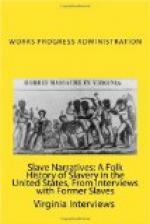2. Place and date of birth—Oak Log Bayou, White River, near Arkansas Post, Ark.
3. Family—Wife and one grown son.
4. Places lived in, with dates—Taken to Texas by his young master and sold in Marshall during the war. Lived in Tyler, Texas until forty-eight years of age; came back to Arkansas in 1897 and stayed until 1922; went to Chicago and lived until 1930; back to Jefferson County, Arkansas.
5. Education, with dates—Two days after twenty-one years of age. No date.
6. Occupations and accomplishments, with dates—Farmer, preacher, common carpenter, cobbler, public work on streets in Chicago, farmed and preached until he went to Chicago in 1922. The he worked in the maintenance department of city streets of Chicago and of Lincoln Park, Chicago.
7. Special skills and interests—Asphalt worker
8. Community and religious activities—Licensed Methodist Preacher. No assignment now.
9. Description of informant—Five feet eight inches tall; weight, 165 pounds, nearly bald. Very prominent cheek bones. Keen intelligence. Neatly dressed.
10. Other points gained in interview—Reads daily papers; knowledge of world affairs.
Pine Bluff District
folklore subjects
Name of Interviewer: Martin — Barker
Subject: Negro Customs
Information by: Ben Moon
[TR: Information moved from bottom of second
page.]
I was born on the Walker place, in 1869. My father was a slave to Mr. Bob. I used to drive Miss Lelia (Eulalie) to the Catholic church here in Pine Bluff. She used to let me go barefooted, and bare headed.
Miss Lelia was the daughter of Col. Creed Taylor. All during slavery time I drove her gins. We had eight mules. Eight at a time hitched to each lever, they would weave in an out but they was so hitched that they never got in any body’s way. They just walked around and round like they did in those days. We had herds of sheep, we sheared them and wove yarn for socks. We raised wheat, when it was ripe we laid a canvas cloth on the ground and put wheat on it, then men and women on horse back rode over it, and thrashed it that way. They called it treading it. Then we took it to the mill and ground it and made it into flour. For breakfast, (we ate awful soon in the morning), about 4 am, then we packed lunch in tin buckets and eat again at daylight. Fat meat, cornbread and molasses. Some would have turnip greens for breakfast.
Summertime, Miss Lelia would plant plenty of fruit, and we would have fried apples, stewed peaches and things.
Sunday mornings we would have biscuit, butter, molasses, chicken, etc.
For our work they paid us seventy-five cents a day and when come cotton picking time old rule, seventy five cents for pickin cotton. Christmas time, plenty of fireworks, plenty to eat, drink and everything. We would dance all Christmas.




